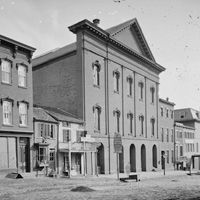The sanctuary of the First Baptist Church of Washington, D.C., has sat vacant for over two years. Constructed in 1833, the building was abandoned when the First Baptist congregation, also known as the Tenth Street Baptist Church, merged with the nearby Fourth Baptist Church in 1859.
The empty building is in a choice location and in need of only minor repairs. Today, John T. Ford, a theater manager and Baltimore native, signs a five-year lease on the abandoned First Baptist Church, including a buy out option at lease’s end.
Despite the disapproval of some members of First Baptist Church, the enterprising Ford immediately turns around and rents the former church building to George Christy who performs there, to critical acclaim, for about three months with a minstrel group. Christy names the building “The George Christy Opera House.” No renovations are made at this time. Even the church pews remain during Christy’s tenure.
At the end of February, Ford closes the theater for renovations. Following three weeks of intense work and a $10,000 investment, the former Baptist church building is reopened to the public under the name of “Ford’s Athenaeum.” All goes well until December 30, when a fire destroys the exterior of the structure. Fortunately, no one is injured in the blaze.
Determined, Ford rebuilds and in August 1863 opens “Ford’s New Theatre.” The new theater quickly becomes popular with locals and tourists alike. In November, U.S. President Abraham Lincoln attends a performance of The Marble Heart, starring an up-and-coming 24-year old actor named John Wilkes Booth. For the next two years, Lincoln is a frequent patron of the theater.
On April 14, 1865 Abraham and Mary Lincoln, accompanied by friends, settle into a box stage left to watch a performance of Our American Cousin. What happens next in the former Baptist church changes the course of history.
John T. Ford’s brother, James, is left in charge of the theatre on this evening. During intermission, Lincoln’s bodyguard goes to the lobby bar for a drink but does not return for the start of Act 3. John Wilkes Booth enters Ford’s through a backstage door with the help of a stagehand and proceeds to Lincoln’s box. At around 10:15 p.m., during the beginning of Act 3 Scene 2, Booth aims his gun and shoots Lincoln in the back of the head by his left ear. Lincoln is rushed to the Petersen House across the street where he succumbs to his wounds early the next morning. Booth escapes until he is apprehended by authorities 12 days later.
Following Lincoln’s assassination, military guards are posted at the theatre and access is permitted only by a special pass from the Judge Advocate’s Office, War Department. John T. Ford receives official permission to re-open the theatre after the hanging of the conspirators occurs on July 7. On July 10, Ford premiere The Octoroon and sells more than 200 tickets for this performance. Troops of soldiers are stationed at the entrance to the theatre to help avoid any issues that may arise. After receiving an anonymous letter threatening to burn the theatre down if it reopens as a place of amusement, Ford is forced to refund all patrons. Shortly thereafter, the theatre is taken over by the government and converted into a three-story office building. Ford is paid $1,500 per month for the lease of his theatre until Congress can purchase it from him.
Thus, the president, a former Baptist, is killed in a former Baptist church building. Lincoln’s assassination takes place as the Civil War ends with the United States victorious. But minus Lincoln at the helm for a second term as president, the immediate aftermath of the war turns into a period of intense political turmoil and confusion, leading to years of southern Reconstruction that prove far less than satisfying for the northern victors, while allowing white southerners the opportunity to continue to violently oppress black citizens.
Meanwhile, Congress purchases the former First Baptist Church building from John T. Ford and eventually converts the structure into government office buildings housing the Army Medical Museum, the Office of the Surgeon General and the War Department.
Sources: “Ford’s Theatre History,” including quote and image above (link); Restoration of Ford’s Theatre, Washington, D.C., United States Department of the Interior, 1963 (link)



